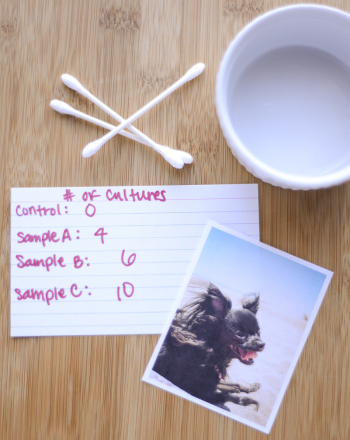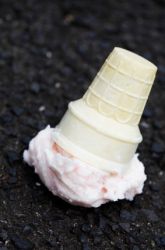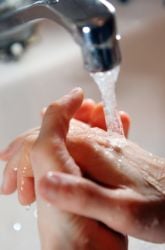Science project
Mouth Bacteria?
It's time to get to sleep, but you're feeling hungry, so you grab a tasty snack before bedtime. That hit the spot!
Eating that late-night apple means you have to go brush your teeth again. Would it hurt to skip just this once? How will the extra germs affect your teeth? Let's find out! In this experiment, you'll be testing different types of food to find out which kind produces the most bacteria in your mouth.
Problem:
Which type of food produces the most mouth bacteria?
Materials:
- 5 Premade Petri dishes with Agar
- 5 cotton swabs
- Apple
- Potato chips
- Bread
- Gummy worms
- Toothbrush
- Toothpaste
- Water
- Small sticky labels
- Marker
- Notebook
- Pencil
- Tape
- Camera
Procedure:
- Using the marker, write "Control" on a label, and stick it to the bottom of your first dish.
- Brush your teeth and gargle with water.
- Swab the inside of your mouth by gently rubbing the cotton swab on the inside of your cheek.
- Rub the swab onto the agar of the first dish. Rub it lightly, and try spreading the saliva, or spit from your mouth, into a straight line.
- Write "Apple" on another label, and stick it to your second dish.
- Eat a few bites of the apple.
- Swab the inside of your mouth.
- Rub the swab onto the agar of the second dish like you did in step 5.
- Brush your teeth and gargle with water.
- Write "Chips" on another label, and stick it to your third dish.
- Eat a few potato chips.
- Swab the inside of your mouth.
- Rub the swab onto the agar of the third dish.
- Brush your teeth and gargle with water.
- Write "Bread" on another label, and stick it to your fourth dish.
- Eat a few bites of the bread.
- Swab the inside of your mouth.
- Rub the swab onto the agar of the fourth dish.
- Brush your teeth and gargle with water.
- Write "Gummy" on another label, and stick it to your fifth dish.
- Eat a few gummy worms.
- Swab the inside of your mouth.
- Rub the swab onto the agar of the fifth dish.
- Cover all five dishes and place them side by side in a dark, dry area.
- Think about the food that your parents only let you have on special occasions, such as birthday parties. What food do they warn you about? Why do you think your parents don't want you to eat these very much? Write down your notes in your notebook.
- Using your thoughts from Step 26, make a guess at which dish will produce the most bacteria, and why you think your guess is correct. Write down this guess—called a hypothesis—in your notebook.
- After a full day, bring your five dishes to a well-lit area.
- Write down any observations—things or changes you notice—about what happened in each dish. Were there any changes? What is different from before? What are the differences between the dishes?
- Using your camera, take a picture of every dish. Print the photos, and tape them into your notebook.
Results:
All the food should have grown bacteria, but the apple and gummy worms should have produced much more bacteria.
Why?
If you don't brush your teeth after eating, all food will cause bacteria to grow, which leads to rotting teeth and bad breath. This is because your mouth is the perfect place for bacteria to multiply, or grow in number. It's dark, moist, and supplied with nutrients that bacteria can eat to grow.
Sugar is the main cause of tooth decay. Both apples and gummy worms have a large amount of sugar in them. Even though apples are healthy for the body, they can cause cavities just as quickly as candy can because of all the natural sugars they have. The bacteria in your mouth thrive on sugar, and after you eat something sugary, it produces an acid that damages your teeth.
The worst time to not brush your teeth is before bed. Your mouth is driest when you sleep and, without saliva breaking it down, bacteria will multiply rapidly. Always brush your teeth at least twice a day—before bed and after you wake up.
What other foods do you think will cause different amounts of mouth bacteria? What do you think would happen if you tested drinks instead of food? Or left the dishes out even longer than a day? The more you learn about preventing the growth of bacteria, the better you can protect yourself against cavities all while perfecting the scientific method!
Education.com provides the Science Fair Project Ideas for informational purposes only. Education.com does not make any guarantee or representation regarding the Science Fair Project Ideas and is not responsible or liable for any loss or damage, directly or indirectly, caused by your use of such information. By accessing the Science Fair Project Ideas, you waive and renounce any claims against Education.com that arise thereof. In addition, your access to Education.com's website and Science Fair Project Ideas is covered by Education.com's Privacy Policy and site Terms of Use, which include limitations on Education.com's liability.
Warning is hereby given that not all Project Ideas are appropriate for all individuals or in all circumstances. Implementation of any Science Project Idea should be undertaken only in appropriate settings and with appropriate parental or other supervision. Reading and following the safety precautions of all materials used in a project is the sole responsibility of each individual. For further information, consult your state's handbook of Science Safety.













